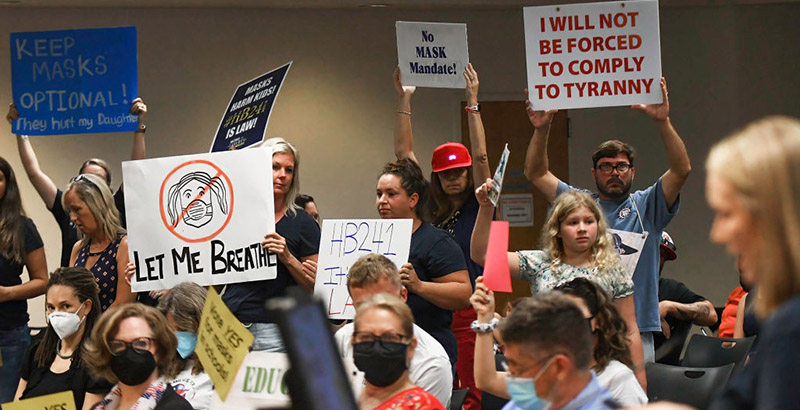Cross: America’s School Boards Are in Crisis. Here Are 9 Ways to Fix That — and Keep the Focus on Educating Children

Get stories like this delivered straight to your inbox. Sign up for The 74 Newsletter
The governing of public schools in many communities is nearing total collapse.
From coast to coast, border to border, local school boards are fighting over matters ranging from painting over Works Progress Administration murals to deciding whether to follow the science on COVID-19 or yield to the loudest voices. There are fights over curricula, toilets, racial issues such as renaming schools, masks, vaccinations and police presence on campuses.
Many of these matters have torn communities apart and led to angry confrontations, even violence, and property destruction.
In a number of communities, people have resigned from school boards or declared they will not run for office due to the intensity of the issues that divide communities. Meanwhile, problems such as student performance, teacher pay and working conditions, and student learning loss during the pandemic remain on the sidelines.
School boards are one the oldest forms of governance in this country. The first one dates back 300 years, to Boston in 1721, decades before the American Revolution and the Constitutional Convention.
Although today’s board members still perform such traditional duties as signing labor contracts and dealing with school maintenance and construction, their role has changed with the times. In larger districts, being on the school board has become a stepping stone to higher office and a way to create name recognition and raise campaign funds.
The United States has what is likely the world’s most fragmented system of governing public K-12 schools. There are 50 state agencies, a variety of intermediate districts and agencies, about 13,500 local school districts and about 100,000 district public schools, as well as over 7,500 public charter schools. Roughly 94 percent of the nation’s 95,000 school board members are elected. The reasons for pursuing an elected board seat include personal agendas, politics or political agendas, and a commitment to serve the best interests of children. In some cases, there is evidence that people are recruited to run for board seats by political and, often, extreme organizations.
In few states are board members required to have any training before they assume responsibility for what may be billions of dollars in spending, thousands of jobs and the futures of, collectively, 50 million students whose interests they are supposed to represent.
With this in mind, here are a number of actions that every state, every school board, can take to improve the governance of our public schools:
- Require newly elected board members to undergo an orientation session on key issues as a precondition for being sworn into office. Be certain it is done by experts, not advocates. This training should make a clear distinction between the governance duties of the board and the management duties of the superintendent and her/his cabinet. They should also receive training focused on protocols and procedures for group decision-making, including civil discourse and dialogue.
- Adopt and enforce a code of conduct expressly crafted for and by the board.
- Adopt a conflict-of-interest policy.
- Create the position of parliamentarian, who is not a board member and can ensure that rules, procedures and the code of conduct are followed.
- Identify the most critical education issues facing the community, and have the board focus on those issues. Ensure that every part of the community has an opportunity to articulate its major concerns.
- Move board elections to a date that will enhance voter turnout. In most school board elections, turnout is in the teens, meaning a single interest group may prevail in electing candidates, whether or not their views reflect the interests of the larger community. Consider holding elections in areas within school districts, so as to ensure wide representation.
- Hold community forums prior to elections and require candidates to participate. Have them run by a professional moderator.
- Establish reasonable term limits so there are opportunities for all parts of the community to be represented.
- Consider having a board that is composed of elected members as well as members appointed by the highest elected official in that jurisdiction. This is done in states like Ohio and in some local areas. In Maryland, there are elected, appointed and hybrid local boards. Many large cities have only appointed members.
In the turmoil being felt in many communities, it is vital that the quality of teaching and learning and the conditions that enable these twin goals be job No. 1. Don’t let school boards become a venue for airing issues that crowd out the focus on children and learning. School boards should not become training grounds for political activism that reaches far beyond the best interests of educators and children.
Christopher T. Cross is a former president of the Maryland State Board of Education and a former U.S. assistant secretary of education. He served as a distinguished senior fellow for the Education Commission of the States.
Get stories like these delivered straight to your inbox. Sign up for The 74 Newsletter

;)